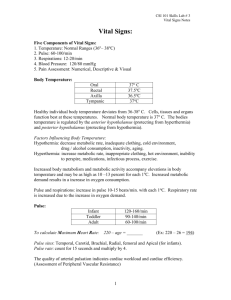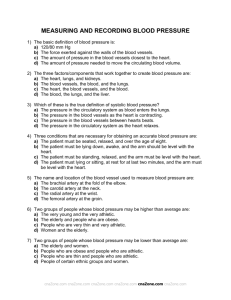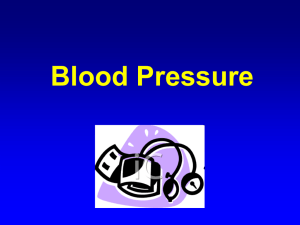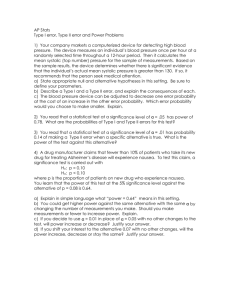LAB EXERCISE #7
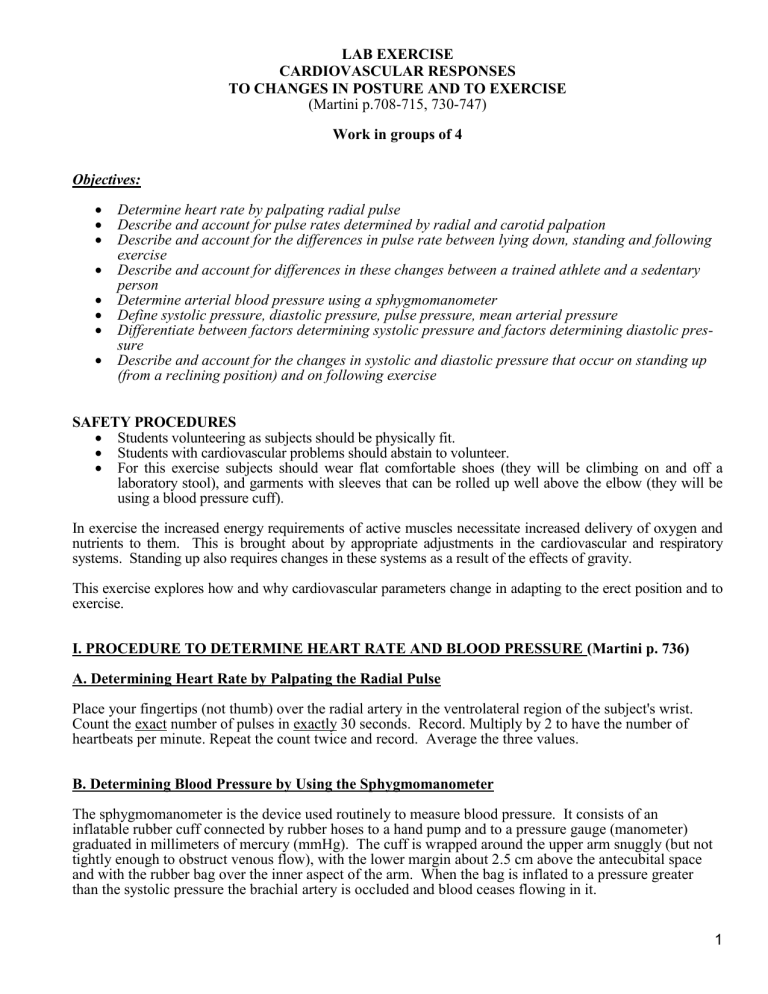
LAB EXERCISE
CARDIOVASCULAR RESPONSES
TO CHANGES IN POSTURE AND TO EXERCISE
(Martini p.708-715, 730-747)
Work in groups of 4
Objectives:
Determine heart rate by palpating radial pulse
Describe and account for pulse rates determined by radial and carotid palpation
Describe and account for the differences in pulse rate between lying down, standing and following exercise
Describe and account for differences in these changes between a trained athlete and a sedentary person
Determine arterial blood pressure using a sphygmomanometer
Define systolic pressure, diastolic pressure, pulse pressure, mean arterial pressure
Differentiate between factors determining systolic pressure and factors determining diastolic pressure
Describe and account for the changes in systolic and diastolic pressure that occur on standing up
(from a reclining position) and on following exercise
SAFETY PROCEDURES
Students volunteering as subjects should be physically fit.
Students with cardiovascular problems should abstain to volunteer.
For this exercise subjects should wear flat comfortable shoes (they will be climbing on and off a laboratory stool), and garments with sleeves that can be rolled up well above the elbow (they will be using a blood pressure cuff).
In exercise the increased energy requirements of active muscles necessitate increased delivery of oxygen and nutrients to them. This is brought about by appropriate adjustments in the cardiovascular and respiratory systems. Standing up also requires changes in these systems as a result of the effects of gravity.
This exercise explores how and why cardiovascular parameters change in adapting to the erect position and to exercise.
I. PROCEDURE TO DETERMINE HEART RATE AND BLOOD PRESSURE (Martini p. 736)
A.
Determining Heart Rate by Palpating the Radial Pulse
Place your fingertips (not thumb) over the radial artery in the ventrolateral region of the subject's wrist.
Count the exact number of pulses in exactly 30 seconds. Record. Multiply by 2 to have the number of heartbeats per minute. Repeat the count twice and record. Average the three values.
B.
Determining Blood Pressure by Using the Sphygmomanometer
The sphygmomanometer is the device used routinely to measure blood pressure. It consists of an inflatable rubber cuff connected by rubber hoses to a hand pump and to a pressure gauge (manometer) graduated in millimeters of mercury (mmHg). The cuff is wrapped around the upper arm snuggly (but not tightly enough to obstruct venous flow), with the lower margin about 2.5 cm above the antecubital space and with the rubber bag over the inner aspect of the arm. When the bag is inflated to a pressure greater than the systolic pressure the brachial artery is occluded and blood ceases flowing in it.
1
To determine the approximate systolic pressure, proceed as follows. Palpate the radial artery and, while feeling the pulse, quickly raise the pressure within the cuff in steps of about 5 mmHg until the radial pulse disappears. The pressure at this point is the systolic pressure. Do not keep the pressure elevated for any longer than is necessary to make the reading. Deflate the cuff and allow the circulation to return to normal.
Determine the position of the brachial artery in the antecubital space by palpation. Place the bell of the stethoscope over it and quickly raise the cuff pressure about 30 mmHg above the systolic pressure. Then release the pressure gradually, at a rate of about 2-3 mmHg per second, by opening the screw-type value adjacent to the hand pump. Listen for the Korotkoff Sounds described below.
At rest, the blood normally flows through the arteries in laminar flow. That is, the fluid in the center part of the stream moves faster than the fluid in the peripheral layers, and there is very little transverse flow or mixing between the two layers (turbulence). Under these conditions the artery is silent when auscultated.
When the sphygmomanometer bag is inflated to a pressure above the systolic pressure, the flow of blood is stopped and the artery is also silent.
As the pressure in the bag is released gradually through the levels between systolic and diastolic pressure, the blood is pushed through between the walls of the flattened and compressed artery in a turbulent flow pattern. The layers of blood are mixed by eddies flowing at angles to the main stream, and the turbulence sets up vibrations in the arterial wall which are heard as sounds in the stethoscope. These are the sounds of Korotkoff.
In practice, as the pressure in the cuff is permitted to fall gradually from above systolic, no sound is heard.
Note the pressure at which the first 'snapping' sound is heard. This is the systolic pressure . As the pressure in the bag is reduced further the sound first becomes quieter, then changes to a louder tapping.
With still further decreases in pressure, the sound changes again from a tapping sound to a muffled or blowing noise. The pressure at which this change occurs should be recorded as the diastolic pressure .
Further reduction in cuff pressure leads to the total disappearance of any sound. If the systolic pressure is determined to be l20 mmHg and the diastolic 80 mmHg, the blood pressure is recorded as l20/80.
The pulse pressure is the difference between systolic and diastolic pressures, in this case l20 - 80
= 40 mm Hg.
The mean arterial pressure is calculated as diastolic pressure + l/3 pulse pressure, in this case
80 + (l/3 x 40) = 93 mm Hg.
Notes :
(l) In some instances, especially in elderly people with arteriosclerosis, there may be a silent period
(auscultatory gap) between the systolic pressure, when snapping sounds are first heard, and the loud tapping phase. This can lead to errors in recording systolic pressure if the manometer is not pumped up high enough before letting it fall. For this reason systolic pressure determination by the auscultatory method should always be checked by palpating the radial pulse.
(2) It is often difficult to determine the exact point when the sound changes from a tapping to a muffled sound. In such cases, the pressure when the sound disappears should be recorded as diastolic pressure.
Both values are sometimes recorded, eg. l20/85/75 (systolic pressure is l20 mmHg). Check by palpation of the radial pulse.
2
II. EFFECTS OF POSTURE AND EXERCISE ON HEART RATE AND BLOOD PRESSURE
NOTE: Measure heart rate and blood pressure simultaneously. One student is the subject, the second determines heart rate, the third determines blood pressure and the fourth records the values and does the calculations. Record results in the space provided.
A. Sitting
EXERCISE A
Equipment:
stopwatch (or watch with second hand)
sphygmomanometer
stethoscope
The subject should be seated comfortably for this count. Practice recording heart rate and blood pressure simultaneously: one student records heart rate, another one records blood pressure.
Heart Rate .
Count the exact number of pulses in exactly 30 seconds. Repeat the count twice and record. Average the three values. Multiply by 2 to have the number of heart beats per minute.
Sitting heart rate 1st 2nd 3 rd Average
Radial pulse ( 30 second count)
Sitting heart rate (beats/min)
(average x 2) =
Blood Pressure .
Practice determining your partner's blood pressure by the auscultatory method while she is sitting comfortably (check against palpatory method) until you record 3 successive readings that are in close agreement. Record these below. Leave the cuff in place but uninflated.
Sitting Blood Pressure (mmHg) 1st 2 nd
3rd Average
Systolic
Diastolic
Calculate, using average values :
Pulse pressure (= systolic - diastolic)
Mean pressure (= diastolic + 1/3 pulse press)
3
B. Reclining
EXERCISE B
Equipment:
stopwatch (or watch with second hand)
sphygmomanometer
stethoscope
Prior to this test the subject should lie down on a laboratory bench with eyes closed and relax completely for a period of 5 minutes before heart rate and blood pressure are determined.
Heart Rate.
Locate the carotid pulse by placing your thumb and fingers on either side of the neck just below and in front of the angle of the jaw. Make 3 counts palpating the carotid pulse and 3 counts palpating the radial pulse, alternating counts between the two locations. Count carefully - there is usually a small but noticeable difference. Record and average your observations below.
DO NOT make these counts simultaneously. If you do the counts will be identical.
Reclining heart rate - carotid pulse 1st 2 nd 3rd Average
Reclining carotid pulse ( 30 sec )
Average reclining heart rate (carotid) (beats/min)
=
Reclining heart rate - radial pulse
Reclining radial pulse ( 30 sec )
1st 2 nd
3rd Average
Average reclining heart rate (radial) (beats/min)
=
Blood Pressure .
Make 3 determinations of systolic and diastolic pressures by the auscultatory method. The arm should be level with the trunk . Determine mean values.
Reclining Blood Pressure (mmHg) 1st 2 nd
3rd Average
Systolic
Diastolic
Calculate, using average values :
Pulse pressure (= systolic - diastolic)
Mean pressure (= diastolic + 1/3 pulse press)
4
The subject has to keep lying down. DO NOT STAND UP before your two lab mates are ready to take resting heart rate and blood pressure measurements before exercise for Exercise C.
C. Standing
EXERCISE C
Equipment:
stopwatch (or watch with second hand)
sphygmomanometer
stethoscope
Leaving the cuff in place, the subject should stand up, and heart rate and blood pressure should be determined immediately . Count pulses for heart rate measurements for 15 seconds only (multiply by 4 for minute counts). Repeat blood pressure and heart rate measurements at 2 and 5 minutes after standing up.
In each case record simultaneously heart rate, systolic and diastolic pressures, and calculate pulse and mean pressures. Stand "easy" in the intervals between counts, not absolutely still.
Heart Rate .
Immediate standing Heart rate 1st 2 nd 3rd Average
Immediately standing radial pulse ( 15 sec )
Immediately standing heart rate (average x 4) =
The subject should remain on her/his feet, "standing easy". At 2 and 5 minutes make 3 15-second counts of the radial pulse and average.
2 minutes after standing Heart rate 1st 2 nd 3rd Average
2 minutes after standing radial pulse ( 15 sec )
2 minutes after standing heart rate (average x 4) =
5 minutes after standing Heart rate
5 minutes after standing radial pulse ( 15 sec )
1st 2 nd
3rd Average
5 minutes after standing heart rate (average x 4) =
Blood Pressure .
Make 1 determination of systolic and diastolic pressure immediately after standing up and at 2 and 5 minutes.
Standing blood pressure Systolic Diastolic Pulse Mean
Immediately on standing
5
2 minutes after standing
5 minutes after standing
Note: if you miss a blood pressure reading or are late taking the blood pressure, simply note the time that the blood pressure was actually taken.
6
D. Exercise
The goal of EXERCISE D is to determine what cardiovascular adjustments take place during and after exercise. Heart rate and blood pressure will be recorded before exercise, immediately after exercise and during the recovery (while sitting). The measurements recorded immediately after exercise illustrate what happens during exercise.
EXERCISE D
Equipment:
stopwatch (or watch with second hand)
sphygmomanometer
stethoscope
While sitting , record pre exercise heart rate and blood pressure measurements. The subject should then run up and down the stairs for 5 minutes. Post exercise measurements should also be done while sitting.
Heart Rate .
Be prepared to make 15 second counts of the radial pulse before exercising, immediately after the exercise is completed and at 30 second intervals thereafter for a total of two minutes. Make one 15 second count of the radial pulse at 4 and 6 minutes after completion of exercise. Calculate heart rate from each of these counts.
Radial Pulse 15 sec count Heart Rate (beats/min)
Before exercise
Immediately after exercising
30 seconds after exercising
60 seconds after exercising
90 seconds after exercising
120 seconds after exercising
4 minutes after exercising
6 minutes after exercising
Blood Pressure .
Record blood pressures before exercising, immediately after completing the exercise and at intervals of 2,
4, and 6 minutes after completion. Calculate pulse and mean pressures.
Systolic Diastolic Pulse Mean
Before exercise
Immediately after exercising
2 minutes after exercising
4 minutes after exercising
6 minutes after exercising
7
E. Effects of Standing Still on Cardiovascular Performance
EXERCISE E
Equipment:
stopwatch (or watch with second hand)
sphygmomanometer
stethoscope
The subject again lies down, closes her eyes and relaxes completely. Check heart rate at 1 minute intervals until counts are consistent. Count the radial pulse for 15 seconds, record below and calculate.
Determine systolic and diastolic blood pressure, record below, and calculate pulse and mean pressures.
The subject then stands up with her back to the wall and remains absolutely still. Don't move your feet - or even wiggle your toes. Record Heart Rate (count the radial pulse for 15 seconds) and Blood Pressure immediately after standing up, 1-minute after standing up, and at 2-minute intervals thereafter for a period of 15 minutes. Record below. If the subject feels faint or dizzy, the experiment should be terminated immediately, and she should lie down again to recover.
Radial pulse
15 sec count
Heart rate
(beats/min)
Systolic
Blood Pressure (mmHg)
Diastolic Pulse Mean
RECLINING
TIME
AFTER
STANDING
(min.)
0
1
3
5
7
9
11
13
15
8
NAME & section #: ________________________________________
EXERCISE 4: CARDIOVASCULAR RESPONSES
TO EXERCISE
INTRODUCTION
State the purpose of this exercise
MATERIALS AND METHODS
See the lab manual.
RESULTS.
Use separate pages.
CARDIOVASCULAR EFFECTS OF POSTURE AND EXERCISE.
1.
Tabulate your results.
2.
Illustrate your results with three graphs.
Cardiovascular effects of standing up from a reclining position: on the same page make two graphs: one graph will show changes in heart rate and the second one, changes in blood pressure (systolic, diastolic and mean arterial pressures). On this same page, describe your results in no more than 5 lines.
Cardiovascular adjustments during exercise and recovery: on the same page make two graphs: one graph will show changes in heart rate and the second one, changes in blood pressure (systolic, diastolic and mean arterial pressures). On this same page, describe your results in no more than 5 lines.
Cardiovascular effects of standing still: on the same page make two graphs: one graph will show changes in heart rate and the second one, changes in blood pressure (systolic, diastolic and mean arterial pressures).
On this same page, describe your results in no more than 5 lines.
9
DISCUSSION.
Use the spaces provided below. Do not use extra pages.
1) Explain why the heart rate differs depending on whether one palpates the carotid or the radial pulse. Which of these is the most normal value?
2) Explain the changes that occur in heart rate and blood pressure when one stands up from a reclining position.
3) How is the response (heart rate and blood pressure) on standing up altered if one stands very still?
Explain. Why does fainting can occur if one stands still for a longer time? How does fainting
"correct" the situation?
10
4) Outline the mechanisms that are responsible for the changes in heart rate and blood pressure that are observed during exercise. Focus on the changes in blood flow through tissues during exercise (what is the stimulus for this change and the effect on heart rate and blood pressure) .
Note: the measurements recorded immediately after exercise illustrate what happens during exercise .
11
